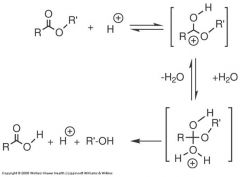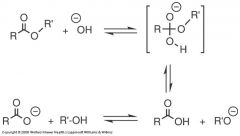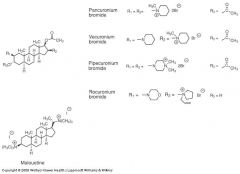![]()
![]()
![]()
Use LEFT and RIGHT arrow keys to navigate between flashcards;
Use UP and DOWN arrow keys to flip the card;
H to show hint;
A reads text to speech;
52 Cards in this Set
- Front
- Back
|
Free acetylcholine that is not bound to a receptor is hydrolyzed by what?
|
acetylcholinesterase (AChE).
|
|
|
how does acetylcholinesterase (AChE) interfere with this mechanism?
|
These molecules interfere with the mechanism by which the action of acetylcholine is terminated (hydrolyzed).
|
|
|
Rapid hydrolysis of acetylcholine by AChE is inhibited, and this leads to the increase in what? What does this result in?
|
this increases the concentration of acetylcholine in the synapse, resulting in production of both muscarinic and nicotinic effects.
|
|
|
The enzymatically controlled hydrolysis reaction parallels the two chemical mechanisms for hydrolysis of esters. What is this reaction known as?
|
acidic and basic hydrolysis of an ester.
|
|
|
Acetylcholinesterase Inhibitors are NOT what?
What do ace inhibitors work to modulate? |
Ace inhibitors
“ACE INHIBTORS” work to modulate Angiotensin Converting Enzyme |
|
|
Draw the acid-catalyzed hydrolysis of an ester.
|

|
|
|
Draw the base-catalyzed hydrolysis of an ester.
|

|
|
|
Acetylcholinesterase inhibitors are classified as what? Why are they classified like this?
|
classified as indirect cholinomimetics, because their principle mechanism of action does not involve binding to cholinergic receptors.
|
|
|
Acetylcholinesterase inhibitors are used therapeutically to improve what?
|
improve muscle strength in myasthenia gravis (caused by circulating antibodies that block acetylcholine receptors at the neuromuscular junction).
|
|
|
Acetylcholinesterase inhibitors are also used in what? What are they used to decrease? How is this done?
|
They also are used in open-angle glaucoma to decrease intraocular pressure by stimulating contraction of the ciliary muscle and sphincter of the iris.
|
|
|
Acetylcholinesterase inhibitors They are used extensively as what? What real world scenario is this used in?
|
insecticides and are in military arsenals for use as chemical warfare agents.
|
|
|
Acetylcholinesterase Inhibitors may be ______ or _____
|
Reversible or Irreversible
|
|
|
Reversible Acetylcholinesterase Inhibitors – Type 1
Inhibitor binds to what? Have greater affinity for what? What don't they do? What are they useful in treatment of? |
Inhibitor binds to AChE enzyme with greater affinity than acetylcholine, but doesn’t hydrolyze. Many of these are useful in the treatment of early stage Alzheimers disease
|
|
|
What 2 drugs are useful in Alzheimers disease?
|
Tacrine
Donepezil hydrochloride |
|
|
Reversible Acetylcholinesterase Inhibitors – Type 2
Inhibitors react with what? What does this form? It is more stable to hydrolysis than what? What is it still capable of? |
nhibitor reacts with serine hydroxyl functional group in acetylcholinesterase to form an carbamylatedenzyme, which is more stable to hydrolysis than the acetylated enzyme from normal enzyne function, but still capable of undergoing hydrolysis to regenerate enzyme.
|
|
|
Regeneration of active AChE (with free serine hydroxyl group) by hydrolysis of the carbamylated enzyme is ____ ___ than hydrolysis of the acetylated enzyme during normal enzyme function.
|
MUCH SLOWER
|
|
|
Irreversible AChE Inhibitors form what? This is very resistant to what? What can this functional group age partially into? What can these agents permantely do to an enzyme?
|
Irreversible AChE Inhibitors form a phosphate ester with the enzyme which is very resistant to hydrolysis. This phosphate ester can also “age” into a partially hydrolyzed phosphate which is even more stable. These agents can permanently deactivate an enzyme.
|
|
|
Irreversible AChE Inhibitors have antidotes which are what? What do functional group do they contain?
|
Irreversible AChE Inhibitors have antidotes which are nucleophiles that rapidly hydrolyze phosphate esters. They contain an oximefunctional group.
|
|
|
Muscarinic antagonists are compounds that have high binding affinity for what? What don't they have?
|
Muscarinic antagonists are compounds that have high binding affinity for muscarinic receptors but have no intrinsic activity.
|
|
|
When the muscarinic antagonist bings to the receptor it is proposed that the receptor protein undergoes what? What does the antagonist binding to the receptor produce?
|
When the antagonist binds to the receptor, it is proposed that the receptor protein undergoes a conformational perturbation that is different from that produced by an agonist. Therefore, antagonist binding to the receptor produces no response.
|
|
|
Because they act as competitive (reversible) antagonists of acetylcholine, these compounds have pharmacological effects that are what?
|
opposite those of muscarinic agonists.
|
|
|
Responses of muscarinic antagonists include what 5 effects?
|
decreased contractions of smooth muscle of the gastrointestinal and urinary tracts, dilation of the pupils, and reduced gastric, mucociliary, and salivary secretion.
|
|
|
What is Atropine used for?
|
Atropine sulfate has a number of clinical uses; two of the most common are treatment of bradycardia and as a preoperative agent to reduce secretions before surgery.
|
|
|
Nicotinic antagonists are chemical compounds that bind to what?
|
cholinergic nicotinic receptors.
|
|
|
ll therapeutically useful nicotinic antagonists are ____ ______? How do they work with acetylcholine?
|
are ompetitive antagonists; in other words, the effects are reversible with acetylcholine.
|
|
|
There are two subclasses of nicotinic antagonist? How are they classified?
|
antagonists—skeletal neuromuscular blocking agents and ganglionic blocking agents—classified according to the two populations of nicotinic receptors.
|
|
|
skeletal neuromuscular blocking agents and ganglionic blocking agents are what kind of blocking agents? What are they primarily used for? What do they produce and facilitate?
|
These compounds are neuromuscular blocking agents - used primarily as an adjunct to general anesthesia. They produce skeletal muscle relaxation and facilitate operative procedures such as abdominal surgery.
|
|
|
What are 5 examples of Nicotinic Antagonists?
|

|
|
|
Adrenergic drugs act to modulate what?
|
modulate adrenoceptors that normally are activated by the neurotransmitter norepinephrine (noradrenaline), or they may directly act on the neurons that release the neurotransmitter.
|
|
|
In the 1940s, norepinephrine was identified as what?
|
the true neurotransmitter at the terminus of the sympathetic nervous system
|
|
|
Norepinephrine and epinephrine are members of a class of pharmacologically active substances known as What? Because they contain within their structure both what?
|
known as catecholamines, because they contain within their structures both an amine and ortho-dihydroxybenzene, which is known by the common chemical name of catechol.
|
|
|
Adrenergic receptors are divided into what classes? according to their responses to different what? Principally what 3 drugs?
|
Adrenergic receptors are divided into α- and β-adrenoreceptorclasses according to their responses to different adrenergic receptor agonists, principally norepinephrine, epinephrine, and isoproterenol.
|
|
|
α-adrenoceptors are stimulated by these agonists in the following descending order of potency:
|
epinephrine > norepinephrine >isoproterenol.
|
|
|
β-adrenoceptors are stimulated in the following descending order of potency:
|
isoproterenol> epinephrine > norepinephrine.
|
|
|
Norepinephrine Has limited clinical application because of what? What does this cause?
|
because of the nonselective nature of its action, which causes both vasoconstriction and cardiac stimulation.
|
|
|
Norepinephrine must by given how? Because why?
|
It must be given intravenously, because it has no oral activity (poor oral bioavailability) as a result of its rapid metabolism by intestinal and liver enzymes, 3-O-glucuronidation/sulfation in the intestine, and low lipophilicity.
|
|
|
What kind of metabolism dose it have? Whats the duration?
|
Rapid metabolism limits its duration of action to only 1 or 2 minutes, even when given by infusion.
|
|
|
Epinephrine, similar to norepinephrine, is used to treat what? Why? What does it stimulate?
|
to treat hypotensive crises and, because of its greater β-activity, to stimulate the heart in cardiac arrest.
|
|
|
The β2-activity of epinephrine leads to its administration how? what else is used in? What does it inhibit?
|
The β2-activity of epinephrine leads to its administration intravenously and in inhalers to relieve bronchoconstriction in asthma and to application in inhibiting uterine contractions.
|
|
|
A major innovation in drug development for the β-adrenergic antagonists was introduced when it was discovered that what could be inserted? What is it inserted in?
|
that an oxymethylene bridge, OCH2, could be inserted into the structure of pronethalolto afford propranolol, the first clinically successful β-blocker.
|
|
|
During clinical trials as an antianginal, propranolol was discovered to have what kind of properties?
|
antihypertensive properties, and it has been widely employed for that purpose for decades
|
|
|
What 2 purposes is propranolol used for?
|
Propranolol rapidly became widely used for a variety of cardiac arrhythmias as well. In addition, because of its high lipophilicity and ability to penetrate the CNS, propranolol has found use in treating disorders of the CNS, such as anxiety.
|
|
|
Therapeutically exploited serotonergic targets include what 3 components?
|
postsynaptic receptors, reuptake mechanisms, and metabolism of 5-HT itself.
|
|
|
Tryptophan depletion, by reducing or eliminating dietary tryptophan, can result in what? . Conversely, tryptophan “loading,” by increasing dietary tryptophan, can result in what?
|
result in decreased 5-HT biosynthesis.
result in the overproduction of 5-HT. |
|
|
What is an example that effectively interfere with the oxidative deamination of 5-HT to increase synaptic concentrations of 5-HT.
|
Monoamine oxidase (MAO) inhibitors
|
|
|
5HT1D Selective Receptor Agonists – the “Triptans” for what?
|
For Migrane
|
|
|
What are the dominant species of serotonergic receptor in human cerebral blood vessels?
|
5-HT1D receptors
|
|
|
5-HT1D receptors are potent what? What kind of people are they contradicted in?
|
They are potent vasoconstrictors and therefore contraindicated for people with cardiovascular problems.
|
|
|
Selective Serotonin Reuptake Inhibitors (SSRIs)
The actions of a neurotransmitter are terminated by what 3 action? |
by diffusion away from the synapse, by enzymatic degradation, and by reuptake into the presynaptic terminal via selective transporters.
|
|
|
Selective Serotonin Reuptake Inhibitors (SSRIs)
Following reuptake, once the neurotransmitter is inside the neuron, it can be what? The reuptake process involves what? |
It can be re-stored in storage vesicles or metabolized. The reuptake process involves a high-affinity transporter protein that is localized in the presynaptic terminal membrane.
|
|
|
Selective Serotonin Reuptake Inhibitors (SSRIs) areagents that block what?
What are they useful in? |
block the transporter and increase synaptic levels of 5-HT.
These are useful for the treatment of depression, obsessive-compulsive behavior, and panic disorders. |
|
|
The ergot alkaloids exhibit affinity for what 3 receptor systems?
|
for α-adrenergic, dopaminergic, and serotonergic receptor system.
|

